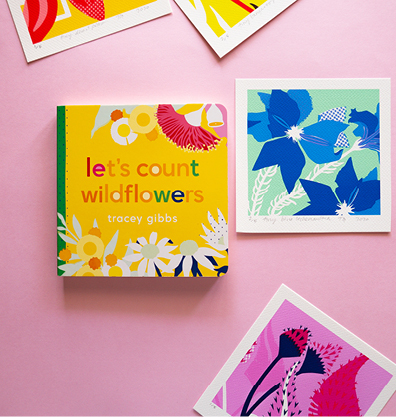Tracey Gibbs shares her love of all things botanical in her pop art board book Let’s Count Wildflowers

Beautiful, bold Australian wildflowers are the heroes of Let’s Count Wildflowers by botanical pop artist Tracey Gibbs, AKA Lalleuca.
Tracey says she sees her new board book as being as much for aunties, carers, teachers, librarians and grandparents as it is for parents. We think her gorgeous counting book is a wonderful way to introduce bubs to the unique, biodiverse world around us. In this article, Tracey takes us back to where her own love of nature began.
As a baby I spent a lot of time on our family farm crawling about the yellow-daisied paddocks with my two trusty companions, Puddles the terrier and Lizzie the sheep. I was a nature baby – enthralled with flowers and plants and bugs. I still have an affinity for snails – at five I was building them hotels from shoeboxes and cardboard tubes, always confused as to how they managed to break free (eat) through the cardboard. I think most of us feel a yearning towards the things that feel familiar, and studying plants and flowers and seeing the busy microscopic universe in the bush is a return to my familiar.

To the best of my knowledge I am not related to May Gibbs, though family storytelling sometimes implies otherwise. I do think that the tenuous, possible connection has informed our family’s affinity with wildflowers and bush babies. Everyone likes to be connected to a legend and I think this connection by name, at least, meant that as a kid I was given May Gibbs’s books quite a lot, which had to have had some effect on me, I’m sure.
I screen-print my work. I study the flowers, sketch and design the form and then I cut paper stencils to create the final artwork, one for each colour, slowly laying down ink over the top of the previous colour. The stencils allow a certain level of imperfection which is beautiful to me. The finished works are both sharp and loose, bold and delicate. It’s that tension between the perfect and the imperfect which feels good to me.

I knew that I wanted the book to be a counting book, one through 10, and that I wanted it to begin at dawn and end at night – to feel like you’ve been on a bushwalk all across Australia for the day. The banksia seed pods, for instance, are at number two. I’ve always seen yawning faces in their open seed pods and their zig-zaggy leaves lend themselves perfectly to arms stretching out to begin the morning, actions familiar to babies and toddlers. We also chose some flowers because of their colours and others because of their names – the flannel flower, an east-coast native, has some lovely alliteration and flannel is also a recognisable word for babies.

I’d love for babies and their grown-ups to feel a sense of joy and peace when they read my book. I’ve always pictured that it would be a wind-down bed time read and I think it will be just as lovely for the adults as it is for the toddlers. It’s a calm, meditative breathing space. And perhaps when they’re all out and about and spot a wildflower, they’ll take some time to watch, connect and count those too.
I started Lalleuca in 2017 and it’s an ever-evolving project. The name is taken from the word melaleuca (an Australian tea-tree). It’s an abstracted, botanical-feeling word without any firm boundaries as to what my practice needs to be, and that about sums up my studio. With Lalleuca, I want to explore the things that bring me joy, and for now, wildflowers are exactly that.

Let’s Count Wildflowers is available in all good bookstores and online. Connect with Tracey on Instagram @Lalleuca.




